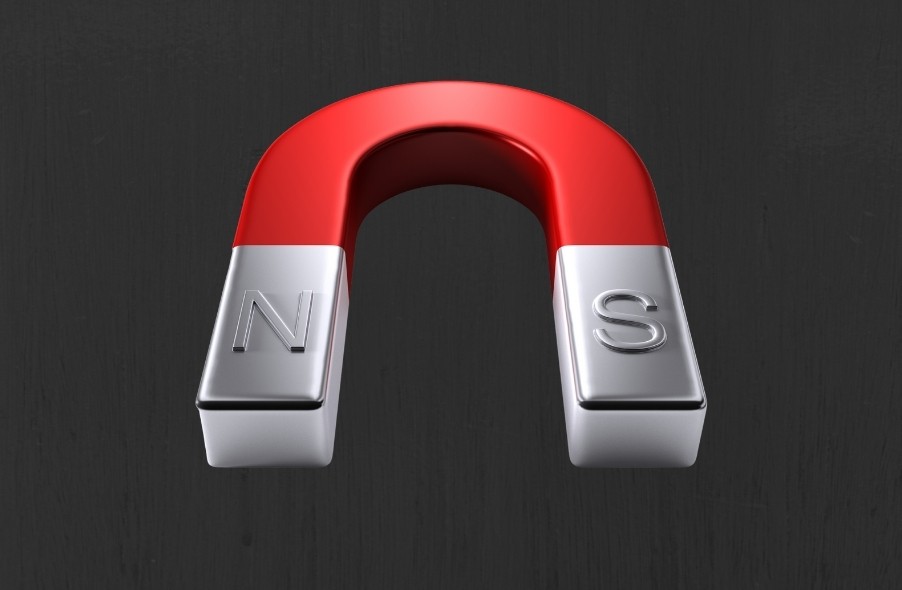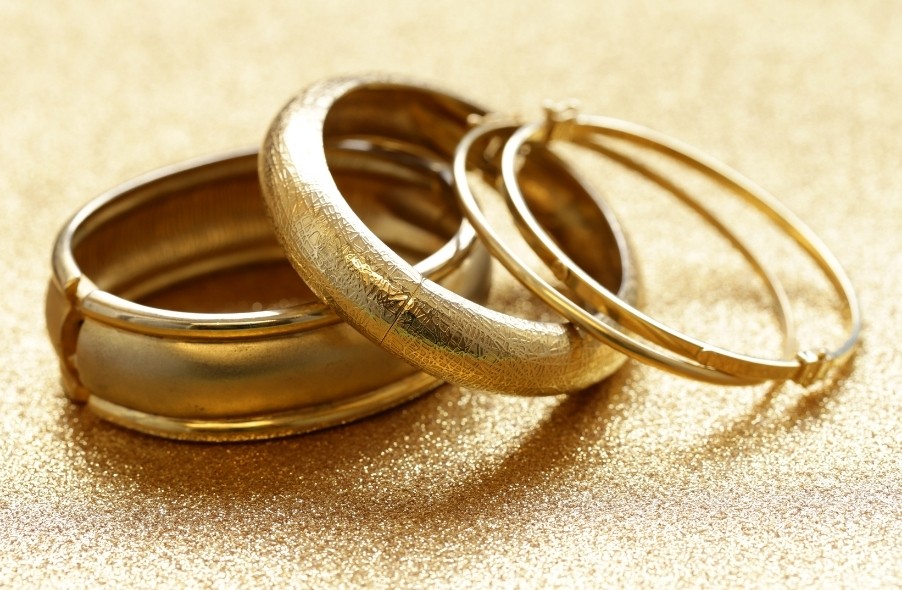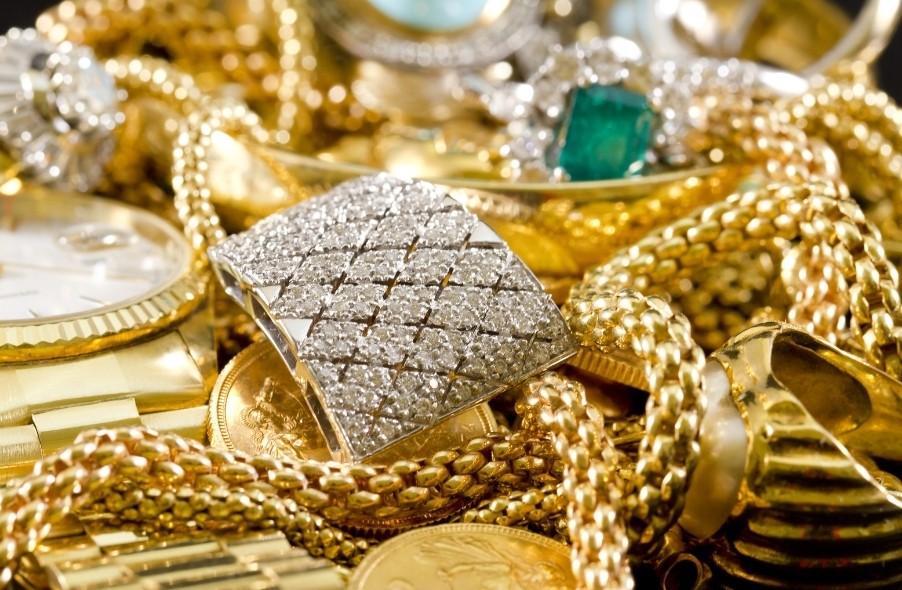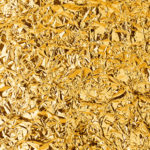When purchasing gold products, you need to understand the various terminologies used to describe the types of gold available.
Many jewelers use enticing words like vintage, expensive, shimmering, and whimsical to get you to make an emotional purchase. These terms don’t mean much as they reveal nothing about the value and durability of the piece you want to buy.
The most expensive gold jewelry pieces consist of pure gold and are described in karats, a term that refers to a product’s gold content. A gold karat measures 1/24 part of the whole piece, signifying the number of gold parts or “purity” in each piece.
Specifically, 24-karat gold stands as the purest gold jewelry you can buy; this designation signifies that the jewelry piece contains 99.9% gold, with no traces of other metals or alloys. But not all gold jewelry available in the market has a composition of pure gold. Popular terms used to describe less-than-pure gold jewelry include gold-filled, gold-plated, and gold-coated.
Here, we mainly examine and define the terms gold-filled and gold-plated while briefly touching on the term gold-coated. Our aim is to help you understand the difference and enable you to make informed and conscious purchases.
But first, let us look at how to determine the purity of solid gold.
How to Determine the Purity of Solid Gold
To determine the purity and quality of gold, you can use several methods, including:
Weight and Density
Gold is a dense metal, so its weight and density can be easily identified. When you drop a piece of gold into the water and measure the amount of liquid it displaces, you can determine its purity based on the resultant weight and density measurements.
However, this test can be unreliable as gold jewelry often contains other metal alloys, which changes the weight and density.
Karat Markings
The karat level determines the purity of gold; the higher the karats, the purer the gold. A karat is 1/24 parts of the gold content. Therefore, a 1/20 12k G.F. marking on a gold piece, for instance, would indicate that the piece has a minimum of 1/20th of 12 Karat gold content by weight.
Higher karat gold is also more malleable than lower karat gold, making it less resistant to wear and tear from scrapes and scratches.
The purest gold you can buy is 24-karat gold.
Magnifying Glasses
Gold professionals also use magnifying glasses and the naked eye to search for signs of flaking. Solid gold will not show any flaking, but gold-plated alternatives may.
Magnets

Experts also routinely use magnets to determine if an item has a high gold content. Gold and other precious metals like silver do not attract magnets, so if a piece attracts a magnet, it is likely not gold, has metal snaps, or consists of a solid-gold alternative.
Porcelain Scratch Test
You can also determine the quality and purity of gold by undertaking the Porcelain Scratch Test. This test uses an unglazed ceramic plate or tile to scratch the gold piece. If the scratch leaves a gold streak, the item is gold, but the item is likely counterfeit if it leaves a black mark.
Gold Acid Test
The gold acid test provides another valuable method for determining the gold content of a jewelry piece, as gold and silver do not dissolve in acid. The test involves applying nitric acid or aqua regia (nitric acid and hydrochloric acid) to the piece. If any part of it dissolves, you can consider the jewelry or item as not made of gold.
X-ray Fluorescence Analysis (XFR)
Finally, many professionals use X-ray fluorescence machines to test the purity of gold. This method costs more than the other methods, but many prefer its non-destructive nature as it leaves the jewelry undamaged.
An X-ray analyzer sends X-rays into the piece, causing the gold atoms to fluoresce energy back to the analyzer. Gold has a specific X-ray fluorescence signature, so the rays can help professionals determine if the piece’s material chemistry is consistent with gold.
Solid Gold Alternatives: What’s the Difference Between Gold-Plated, Gold-Filled, and Gold-Coated?
Not all gold jewelry on sale consists of pure gold. Many gold pieces have a lesser base metal at their core and a layer of precious metal on the surface.
This compromise makes them more affordable while retaining their durability and value. The process of bonding the precious metal onto the base metal often determines the value of a piece.
Gold alternatives can be produced using three main methods:
- Gold filling
- Gold plating
- Gold coating
Here we examine each of these production processes and see how they impact value.
Gold-Filled Jewelry
Gold-filled jewelry consists of two to three layers of gold, pressure-bonded at various high temperatures and pressures onto a metal base such as brass or copper. This process results in a much thicker gold layer compared to gold-plated or gold-coated jewelry.
Gold filling allows jewelers to produce solid gold alternatives that yield durable, tarnish-proof pieces. This popular method also delivers jewelry that retains its value and original condition for longer, often up to 30 years. This jewelry provides an economical but durable option over pure gold but can come with a medium-to-high price tag.
Gold-filled jewelry must legally contain 1/20 parts of gold by weight or 5% gold content. The gold content is indicated by the number of gold karats on the piece’s surface, with the best pieces having 12-karat or 14-karat gold, stamped as 12/20 G.F. or 14/20 G.F.
Gold-Plated Jewelry
Gold-plated jewelry, also known as PVD (Physical Vapor Deposition) jewelry, offers another type of gold alternative.
Gold plating blasts precious metals in vaporized form onto a solid base of less precious metal, typically brass, bonding the two metals. Gold plating provides ten times the durability of gold coating but contains only a minute layer of solid gold, estimated at 0.05% by content compared to the 5% content in gold-filled pieces.
The jewelry produced still proves susceptible to scratching, water damage, and heat damage but more resistant to damage from corrosive elements such as sweat, saltwater, and acids.
Gold-Coated Jewelry
Gold coating does not produce high-quality, durable jewelry compared to gold filling and gold plating.
Gold-coating adds a thin layer of precious metal, typically gold, silver, platinum, or chromium, onto the base of less-precious metal such as silver, brass, or copper. The coating is applied via electrochemical plating, which involves immersing the base into electrically charged precious metal in liquid form. The base attracts the precious metal, which then gets coated.
Jewelers often use this process as an inexpensive and easy method of jewelry production. However, the final product holds less value considering the minimal amount of gold content in the finished piece. In addition, the jewelry tends to tarnish, flake, and chip easily. Still, these pieces have some value as they are incredibly affordable and appeal to the mass market.
Which Jewelry Should You Buy: Gold-Filled or Gold-Plated?

Gold Filled
Gold-filled jewelry has a high gold content, making it much more valuable and durable than other solid gold alternatives.
This type of gold jewelry has been known to retain its condition for up to three decades as it won’t easily chip, tarnish, or flake. However, if exposed to high sulfide levels, for instance, during a fire, in polluted shipping containers, or nail salons with high levels of sulfide fumes, they can blacken.
Gold-filled products generally cost more, given their high gold content. However, they make a great option for persons who suffer from metal allergies. The old layer won’t tarnish quickly, protecting their skin from the base metal.
Gold Plated (PVD)
Gold-plated jewelry provides an excellent choice if you want to purchase low- to medium-priced jewelry. You may want to opt for this relatively durable jewelry due to its titanium nitride bond that strongly bonds the precious metal to the base metal.
Although this jewelry shows susceptibility to scratching and scraping, the repairs can diminish the resulting wear and tear using a process known as replating. This type of gold jewelry can last from five to ten years.
Purchasing gold products is a highly subjective decision. Therefore, deciding which type of solid gold alternative to acquire depends on your budget, sensitivity or allergies to any of the jewelry’s components, and personal preference.
In a nutshell, gold-coated products provide less value in the long term due to their minimal gold content and low durability. Gold-filled products retain their condition longer than gold-plated products but will likely cost you more.
Final Thoughts
If you want to purchase solid gold alternatives for your use, gift to friends or family, or sell professionally, gold-filled and gold-plated pieces make excellent choices. These gold pieces do not have the expensive price tag of pure gold and look just as attractive. They are also quite durable, with many pieces maintaining their look and condition for between five and thirty years.
At Learn About Gold, we help you make the right choices when making gold investments. Whether you prefer to invest in gold jewelry, Gold ETFs, or Gold IRAs, we are your central resource for everything gold-related.
We also connect you with reputable partners offering affordable gold investments. Contact us now to learn more.





